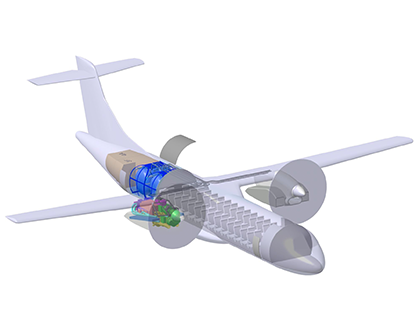
Flight of largest hydrogen fuel cell powered airplane ever recorded
Universal Hydrogen Co., flew a 40-passenger regional airliner using hydrogen fuel cell propulsion. The airplane, nicknamed Lightning McClean, took off at 8:41am PST from Grant County International Airport (KMWH) and flew for 15 minutes, reaching an altitude of 3,500 MSL. The flight, conducted under an FAA Special Airworthiness Certificate, was the first in a two-year flight test campaign expected to culminate in 2025 with entry into passenger service of ATR 72 regional aircraft converted to run on hydrogen. Representatives from Connect Airlines and Amelia, the US and European launch customers for the hydrogen airplanes, respectively, were on hand to witness the historic flight. The company has a rapidly growing order book, today totaling 247 aircraft conversions from 16 customers worldwide, totaling over $1 billion in conversions backlog and over $2 billion in fuel services over the first ten years of operation.
The company, bThe company’s powertrain is built around Plug Power’s ProGen family of fuel cells specially modified for aviation use. One of the unique aspects of the design is that the powertrain does not use a battery—the fuel cells drive the electric motor directly—drastically reducing weight and cost. The motor, a modified magni650 electric propulsion unit, and power electronics were supplied by Everett-based magniX. Seattle-based AeroTEC assisted with engineering efforts, including design of the modified nacelle structure, aircraft systems design and integration, as well as aircraft modifications and installation of the Universal Hydrogen powertrain onto the flight test aircraft, accomplished in less than 12 months.

Backed by GE Aviation, Airbus Ventures, Toyota Ventures, JetBlue Ventures, and American Airlines, as well as several of the world’s largest green hydrogen producers and top-tier financial investors, plans to springboard from regional airplanes to larger ones and to hydrogen fuel deliveries for other mobility applications using its modular logistics network. “More than half of aviation CO2 emissions today come from the A320 and 737 family of aircraft,” said Eremenko. “Both Airbus and Boeing will need to replace these venerable airplanes with a new design starting development in the late-2020s and entering passenger service in the mid-2030s. Making their successors hydrogen airplanes is a golden opportunity—perhaps the only opportunity—for aviation to get anywhere near meeting Paris Agreement emissions targets without having to curb aviation traffic volumes.”
The hydrogen-powered airplane is not just a revolutionary new product; it is a symbol of hope and progress, a beacon of light in a world that desperately needs it. Today marks a new chapter in the history of aviation and the fight against climate change. Universal Hydrogen is leading the charge, and the world is taking notice.
Information Source: Read More “
Energy Monitors , Electric Power , Natural Gas , Oil , Climate , Renewable , Wind , Transition , LPG , Solar , Electric , Biomass , Sustainability , Oil Price , Electric Vehicles,

